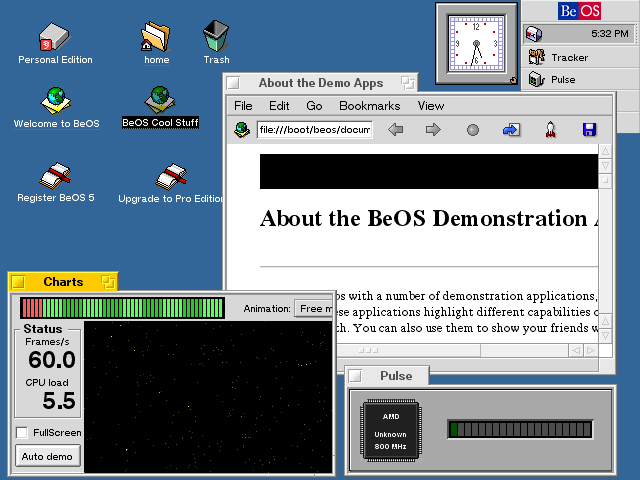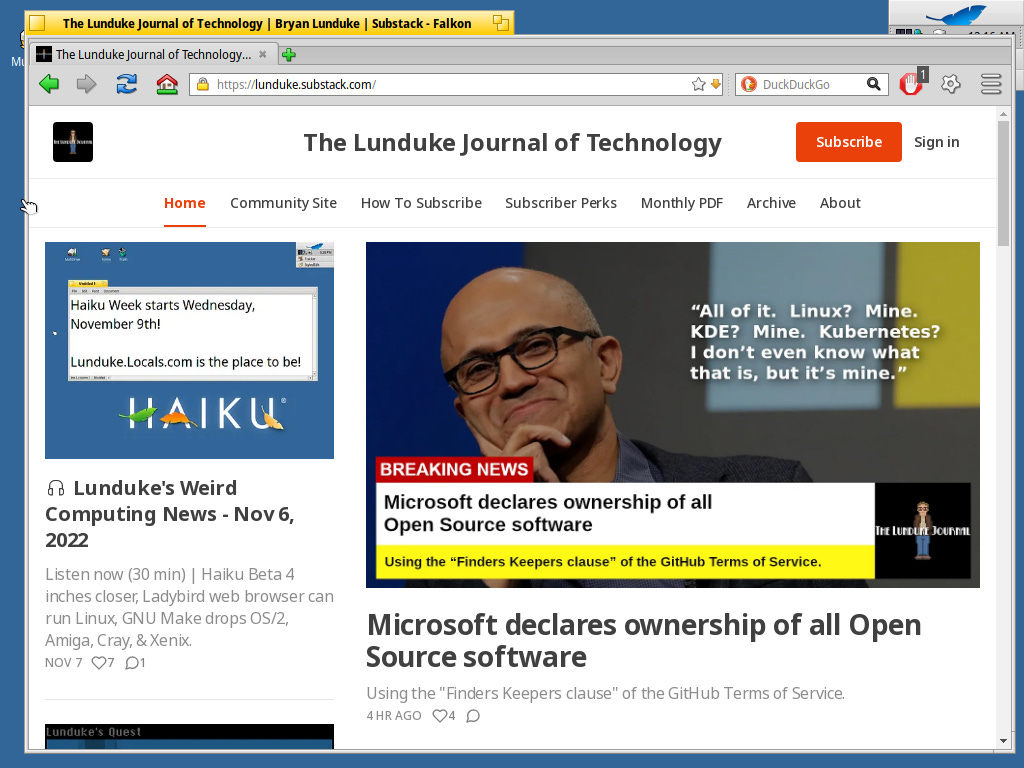Haiku Week begins at The Lunduke Journal
November 9 through November 16 -- Haiku Operating System goodness.
Starting right now — and running through Wednesday, November 16th — we are immersing ourselves in all things related to the Haiku operating system here at The Lunduke Journal.
Let Haiku Week begin!
This is the third themed week at The Lunduke Journal — the first two: DOS Week and Command Line Week were an absolute blast. With PDA Week and 8-Bit Week coming up in December and January.
What is Haiku?
During the 1990s, Be Inc. — started by Jean-Louis Gassée (former Apple executive, who is responsible for starting the project which became the Apple Newton) — developed a truly unique and fascinating operating system: BeOS.

The BeOS was lightning fast and capable of effectively using the power of multiple CPUs (through something dubbed “pervasive multi-threading”) and, because of that, was astoundingly responsive and good at multimedia.
In fact, at one point, BeOS was considered to be the replacement for Apple’s MacOS 8/9 line (which eventually went to OpenStep instead, resulting in MacOS X).
Despite this amazing operating system… Be Inc. eventually failed and was sold off for scrap to Palm.
Shortly thereafter, the OpenBeOS project was started. The goal was to support the existing BeOS users… while developing replacement, open source components for BeOS itself. Eventually resulting in an entirely new — but BeOS compatible — system.
Eventually this morphed into “Haiku”, with a company established behind it. Progress steadily continued in the years that followed — with a dedicated, small group of ragtag enthusiasts and developers. Nowadays Haiku has one full time programmer and makes truly impressive progress on a monthly basis.
How to get started with Haiku
So. You want to try Haiku out, eh? Here’s what I recommend.
First: You’ll want to use the Nightly builds of Haiku, which you can grab an ISO for from the Haiku Nightly download page
Why? Because Haiku is on the cusp of releasing Beta 4. Their internal timeline currently lists that release as being roughly 2 to 3 weeks out. However, a little birdy tells me that this could be moved closer… a few weeks as well. Literally… this could happen very, very soon.
As such, repositories for “HaikuPorts” (the software collection repository) is being built against Beta 4… thus you can expect that software to stop supporting Beta 3 over the coming days.
So. Download the Nightly build, if you want software to function.
But… there’s a downside there. The Nightly builds have lots of debugging and whatnot. Which means lower performance.
Want to fix that? Luckily you can move from the Haiku “Nightly Build” to the current “Beta 4” release candidates via a couple of quick command line tricks.
What’s even better… when Beta 4 is officially released… a quick update and your entire Haiku system will now be upgraded to Beta 4 as well.
Upgrading Haiku Nightly to Beta 4
Open the terminal (in the Application menu) and run the following:
pkgman list-repoThat will result in something that looks like this:
See those “base-url”s? You’ll want to copy the first one, remove the word “master” and replace it with “r1beta4”. Then run the following in the terminal:
pkgman add-repo [That URL]It will look something like that. When it asked you to “overwrite?”… say yes.
Now repeat the same thing for the second URL (“HaikuPorts”).
You have now changed your repositories to pull from the official Beta 4 ones.
At this point… you’ll run:
pkgman full-syncWhich will upgrade your existing Haiku system to the latest build of Haiku R1 Beta 4. It’ll look like the screenshot below. Say “yes”.
Whamo. Reboot and you are now running the latest release candidate for Haiku Beta 4 (or Beta 4 final, itself, once that is released).
Software Recommendations
You’ll want a Web Browser.
Launch “HaikuDepot” from the Application menu. HaikuDepot is your graphical front end to the software repository.
Search for “Falkon”. That, at the current time, seems like the most capable web browser available. It’s a little crashy. But, honestly, it seems to work with most web sites I’ve tested against (including Lunduke.Locals.com and Lunduke.Substack.com).
There are many familiar software packages available for Haiku: GIMP, DOSBox, and so many others (as well as BeOS / Haiku specific pieces of software). Take some time to explore and share your findings with the rest of The Lunduke Journal community.
Some Hardware Thoughts
You can run Haiku on both bare metal hardware, as well as within a virtual machine.
If you want to experience the truly blistering speed of Haiku… you’ll need to run it on bare metal hardware. It just doesn’t run quite as peppy in a virtual machine (but it does run).
You can find a basic hardware compatibility list here, as well as threads on the Haiku Forum discussing compatibility with various laptops and desktops.
I’ve found that there are two areas where I tend to encounter compatibility issues on most laptops:
WiFi
Touchpad mice (most work, some don’t)
Both work well on some laptops… but not all. On my Microsoft Surface Go, for example, everything works amazingly well (and astoundingly fast for a lower end machine like that)… except WiFi.
If you encounter Touchpad Mouse issues… I recommend a simple USB mouse. Works like a charm (I tend to use a USB trackball anyway, so this doesn’t hurt my usage).
For WiFi, there are a two options that might be worth looking at:
USB WiFi adapter (some Realtek chipsets are supported, such as RTL8821AU / 802.11AC).
And smartphone USB tethering.
Note: I have not personally tested the smartphone tethering yet. But, supposedly, you can plug in some Android phones, go into your settings, and select USB Tethering… this is high on my list of things to test — in depth — during Haiku Week.
Where to take part in Haiku Week
I will be posting some additional Haiku-related content here on Lunduke.Substack.com. So be sure to have at least the Free Subscription here… that’ll let you follow along and see some of the results.
Most of the community activity will be happening over on The Lunduke Journal Community site at Lunduke.Locals.com. You’ll want to sign up over there to join in the fun.
Note: Both Founding Member and Lifetime Subscriptions to The Lunduke Journal also come with complimentary full access to both Substack and Locals. Highly recommended.
The Lunduke Journal Discord server also has a dedicated Haiku chat channel. All Lunduke Journal Subscribers (Standard, Founding Member, or Lifetime) have access to the Discord Server.
Before we dive in and immerse ourselves in the world of Haiku I want to say one final thing:
Remember that we are working with Nightly Development and Beta 4 pre-release versions here. While Haiku has been advancing and improving rapidly — expect some bugs. If you encounter issues, talk to folks in the community. On both Locals and Discord. Someone may be able to help. We’re helpful like that.
With that… let Haiku Week begin! See you all in the community!









I wrote up a history of Be and BeOS: https://www.abortretry.fail/p/be-is-nice-end-of-story
I hope some of you enjoy it!